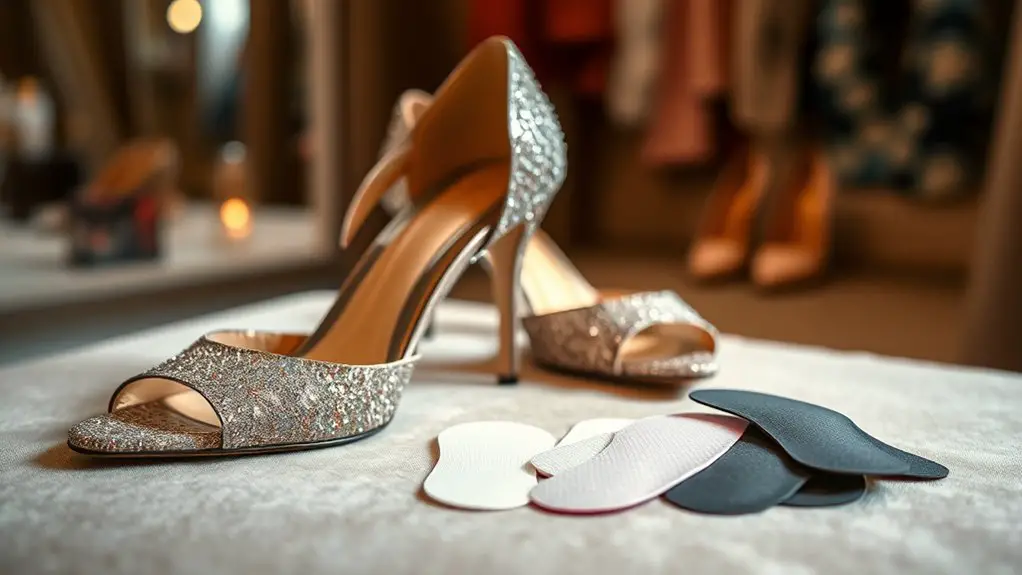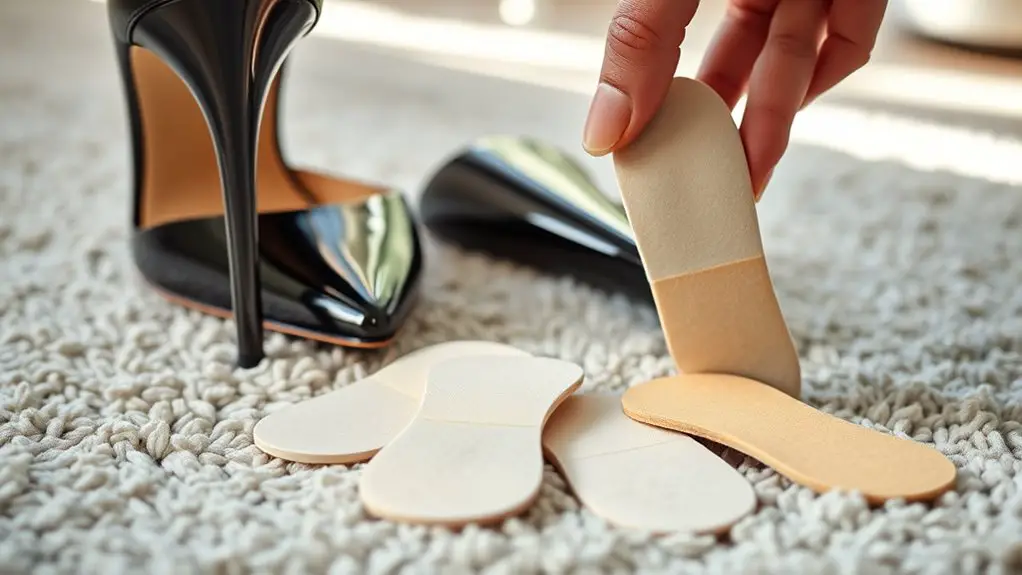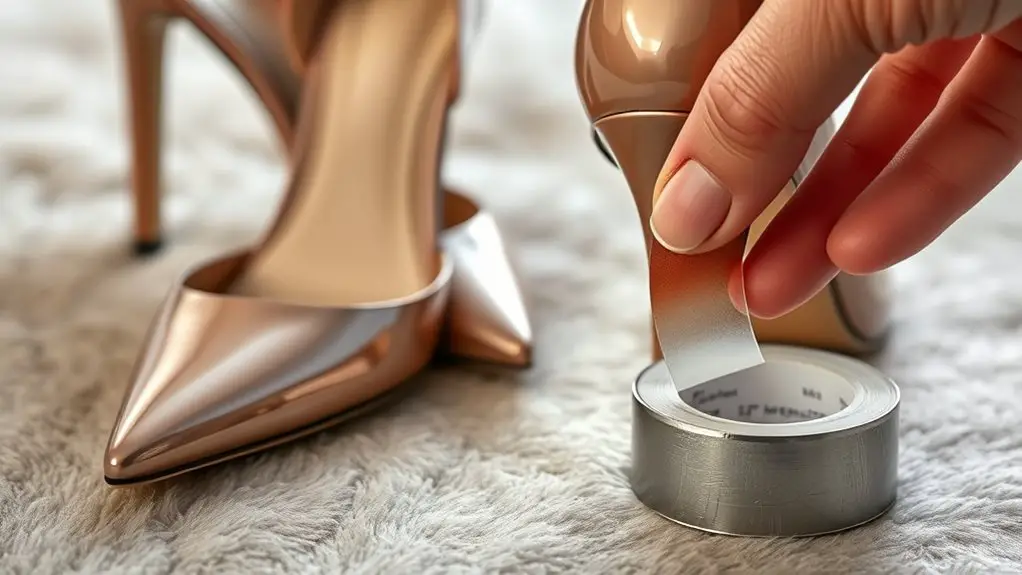To adjust loose high heels for a perfect fit, try using heel grips or pads for extra stability. Adding insoles provides important cushioning and support, while double-sided fashion tape can offer a temporary fix. You might also consider wearing thicker socks or upgrading to professional shoe repair for a more permanent solution. By implementing these strategies, you’ll improve comfort and stability, and you’ll find even more tips for achieving that perfect fit ahead.
Understanding the Causes of Loose High Heels

Understanding the causes of loose high heels is essential for finding effective solutions. One primary factor is the mismatch between your heel size and the shoe’s design. If the heels are too big, they won’t provide the secure fit you need. Additionally, foot shape plays a significant role; if you have a narrower or wider foot, standard-sized heels may not accommodate your unique contours.
Another common reason for looseness is the material of the shoe. Softer materials tend to stretch over time, leading to a less snug fit. Also, the height of the heel can affect stability—taller heels may exacerbate the feeling of looseness if they’re not well-fitted.
Finally, changes in your foot size due to weight fluctuations or age can also contribute to loose high heels. Recognizing these factors can help you better understand your footwear needs and make informed adjustments.
Using Heel Grips for a Snug Fit
If you’re struggling with loose high heels, heel grips can be a simple yet effective solution. These adhesive pads come in various types and can easily be applied to the inside of your shoe for a more secure fit. Understanding the benefits and application process will help you choose the right grip for your needs.
Types of Heel Grips
Heel grips are essential accessories for anyone looking to enhance the fit of their high heels. They come in various types, each designed to improve grip effectiveness while catering to different heel grip materials. Here’s a quick overview to help you choose the right one:
| Type of Heel Grip | Material | Best For |
|---|---|---|
| Silicone | Soft, flexible | Comfort and cushioning |
| Foam | Lightweight | Reducing foot slippage |
| Gel | Shock-absorbing | Long wear and support |
Selecting the right heel grip can make a significant difference in how your heels feel. By understanding these types, you’ll be able to find the perfect fit and enjoy your favorite heels pain-free.
Application Process Explained
To achieve a snug fit with your high heels, it’s essential to apply heel grips correctly, guaranteeing they adhere securely and provide the desired comfort. Start by cleaning the inside of your shoe’s heel area to remove any dirt or oils. This enhances grip adhesion. Next, choose the right placement for the heel grips; typically, they go at the back of the heel. Carefully peel off the backing and press the grips firmly in place, using application techniques that guarantee they’re aligned correctly. You might need to adjust the grips slightly after placing them, but avoid repositioning them multiple times to maintain their stickiness. These fit adjustments will help eliminate slipping and provide that perfect fit you’re looking for.
Benefits of Using Grips
Applying heel grips not only helps with a snug fit but also brings several advantages that enhance your overall comfort and confidence in high heels. By incorporating these grips, you can experience:
- Reduced Slippage: Grip materials guarantee your feet stay firmly in place, minimizing the risk of blisters and discomfort.
- Improved Stability: With better grip effectiveness, you’ll walk with more confidence, reducing the chances of wobbling or stumbling.
- Enhanced Longevity: Protects your heels from wear and tear, extending their life.
These benefits make heel grips a practical addition to your footwear arsenal. When you choose high-quality grip materials, you enhance the overall fit and feel of your favorite pairs, allowing you to focus on looking fabulous without sacrificing comfort.
Adding Insoles for Extra Padding
Adding insoles can greatly enhance the fit of your loose high heels by providing extra padding and support. When selecting insoles, consider various insole materials like gel, foam, or silicone, each offering unique benefits. Gel insoles often provide excellent shock absorption, while foam can deliver a softer feel.
To achieve a snugger fit, choose insoles with ideal thickness; around 3 to 5 millimeters is typically perfect. This thickness offers enough cushioning without making the shoe too tight. Before inserting, verify the insoles fit properly within the shoe’s structure.
You can trim some insoles to match your heel’s shape if necessary. By adding insoles, you not only improve comfort but also help with weight distribution, reducing the risk of blisters or discomfort during prolonged wear. So, invest in quality insoles to elevate your high heels’ fit and overall wearability.
Trying Heel Pads for Improved Stability

If you’re struggling with loose high heels, trying heel pads can greatly enhance your stability. There are various types of heel pads available, each offering unique benefits that can help secure your foot in place. In this section, we’ll explore application techniques and the advantages of using heel pads to improve your overall comfort and confidence while wearing heels.
Types of Heel Pads
Heel pads are a practical solution for enhancing stability in loose high heels. With various types available, you can choose the right heel pad based on your needs. Consider these options:
- Gel pads: Soft and cushioned, providing shock absorption and comfort.
- Foam pads: Lightweight and flexible, offering a snug fit and reducing slippage.
- Silicone pads: Durable and adhesive, guaranteeing they stay in place while providing excellent grip.
When selecting heel pad materials, think about the level of comfort and support you desire. Additionally, explore adhesive options to guarantee your heel pads adhere securely, preventing any unwanted movement. With the right heel pads, you’ll enjoy enhanced stability and confidence in your high heels.
Application Techniques Explained
After selecting the right heel pads for your high heels, the next step is applying them effectively to maximize stability. Start by ensuring your shoes fit snugly but comfortably, as adjusting the shoe width can greatly enhance your overall experience. Clean the inside of your heels to remove any dust or oils, allowing the pads to adhere better. Position the heel pads precisely where your foot tends to slip, typically at the back of the shoe. Press firmly to secure them in place, using fitting techniques like trying on the shoes afterward to check for comfort and stability. Adjust their placement if necessary, ensuring they provide the support needed without compromising the shoe’s design.
Benefits of Using Pads
Using heel pads can greatly enhance the comfort and stability of your high heels, especially when you find them slipping or feeling loose. The right pad materials and thoughtful pad design can make all the difference in how your heels fit and feel.
- Cushioning: Soft gel or foam pads provide a plush feel, absorbing shock and reducing pressure on your feet.
- Grip: Anti-slip surfaces keep your foot securely in place, preventing unwanted movement with each step.
- Support: Arch support pads can alleviate strain, ensuring your heels don’t just fit but also support your foot structure.
Utilizing Double-Sided Fashion Tape

Sometimes, a simple solution can make all the difference when it comes to securing loose high heels. Utilizing double-sided fashion tape is a quick and effective temporary solution that can help keep your shoes snug and stable. To apply it, simply cut a small piece of tape and place it on the inside of your shoe, where it meets your foot. Press your foot firmly against the tape, ensuring a secure fit.
This method works well for both the heel and the insole, providing an extra grip that prevents slipping. Fashion tape is especially handy for special occasions when you want your shoes to look and feel perfect without the hassle of permanent alterations. Just remember, it’s a temporary fix, so check your tape before each wear. With this simple trick, you can enjoy your heels without the fear of them slipping off, making your experience much more enjoyable.
Adjusting Straps for Better Support
While double-sided fashion tape provides a quick fix for loose high heels, adjusting the straps can offer a more secure and long-lasting solution. Proper strap adjustments not only improve fit but also enhance support, reducing the risk of slipping. Here’s how you can achieve effective support enhancements:
Double-sided tape is a quick fix, but strap adjustments provide a more secure, lasting solution for high heels.
- Tighten the ankle straps: This secures your foot in place, preventing any unwanted movement.
- Adjust the toe straps: A snug fit here ensures your toes are comfortably positioned, minimizing pressure points.
- Check for even tension: Verify that both sides of the shoe are equally adjusted, promoting stability and balance.
Exploring Shoe Inserts for Enhanced Comfort
If you’re looking to boost comfort in your high heels, exploring shoe inserts can be a game-changer. These inserts not only improve fit but also enhance overall shoe comfort, making your heels more enjoyable to wear. When selecting inserts, consider various insert materials tailored to your needs.
| Insert Type | Benefits |
|---|---|
| Gel Inserts | Shock absorption, cushioning |
| Foam Inserts | Lightweight, soft support |
| Arch Support | Improves foot alignment |
| Leather Inserts | Breathable, durable |
| Silicone Inserts | Flexible, molds to foot shape |
Using the right inserts can transform your high heels from painful to pleasant. They can help prevent blisters, provide arch support, and alleviate pressure points. So, don’t underestimate the power of shoe inserts—investing in the right ones can make all the difference in your comfort level.
Opting for Thicker Socks or Stockings
If your high heels feel loose, opting for thicker socks or stockings can greatly enhance fit and comfort. You’ll want to reflect on the benefits of added cushioning, as well as how to choose the right materials that won’t compromise the look of your shoes. Layering techniques can also provide a snugger fit, ensuring you walk confidently without worrying about slipping.
Benefits of Thicker Socks
One effective solution for adjusting loose high heels is opting for thicker socks or stockings. Not only do they provide a snugger fit, but they also enhance your comfort and style. Here are some benefits of thicker socks:
- Cushioning: Thicker sock materials add cushioning, reducing pressure on your feet during long wear.
- Warmth: They offer additional warmth, making them perfect for cooler weather or evening outings.
- Versatility in Style Combinations: Thicker socks can be paired with various high heel styles, allowing you to experiment with different looks, from casual to chic.
Choosing the Right Stockings
Choosing the right stockings can greatly impact the fit and comfort of your high heels. When selecting stockings, consider various stocking materials like cotton, nylon, or wool, as they provide different levels of thickness and elasticity. Thicker materials can fill gaps in loose heels, ensuring a snugger fit. Additionally, explore different stocking styles such as knee-highs, thigh-highs, or footed options. Each style serves a unique purpose, with knee-highs often offering more coverage and support. Opting for the right combination of material and style not only enhances comfort but also elevates your overall look. Remember, the right stockings can make a significant difference in how your high heels feel and fit throughout the day.
Layering Techniques for Fit
Thicker socks or stockings can be a game-changer when it comes to achieving a more secure fit in loose high heels. By utilizing layering materials, you can effectively use adjusting techniques to fill out the space and enhance comfort. Here’s how you can do it:
- Choose a thicker fabric for added cushioning and warmth.
- Opt for knee-high or crew-length styles to prevent slipping while maintaining a chic look.
- Experiment with different textures like wool or cotton blends for both style and practicality.
These layering techniques not only help in securing your heels but also add a touch of personality to your outfit. So, don’t hesitate to play around with various combinations to find what works best for you!
Considering Professional Shoe Repair
Have you ever wondered whether professional shoe repair could be the solution to your loose high heels? Seeking out shoe repair services can be a game changer when home remedies just aren’t cutting it. Professional cobblers have the expertise to adjust your heels precisely, ensuring a comfortable and secure fit. They can evaluate the shoe’s structure and recommend options like adding padding, resizing, or even reinforcing the heel.
Choosing to invest in professional shoe repair not only enhances your comfort but also prolongs the life of your favorite pair. A well-fitted shoe can prevent slips and provide better stability, making your heels wearable again. Before dismissing your beloved high heels as unwearable, consider consulting a skilled cobbler who understands the nuances of shoe construction. With their help, you’ll find that achieving the perfect fit may be simpler than you think.
Tips for Preventing Future Slippage
Slippage in high heels can be frustrating, but there are effective strategies to prevent it. By taking a few proactive steps, you can enjoy your heels without worrying about them slipping off.
- Choose the right size: Make sure your heels fit snugly, considering foot swelling that can occur throughout the day.
- Opt for non-slip soles: Applying non-slip pads or grips can enhance traction on slippery surfaces, providing better stability.
- Use heel grips or inserts: These cushion the back of your heels, preventing slippage while adding comfort.
Frequently Asked Questions
Can I Use Adhesive Products on Leather High Heels?
You can use specific adhesive types on leather high heels, but be cautious. Confirm they’re suitable for leather care to avoid damage. Test on a small area first, and follow instructions for best results.
How Do I Clean Heel Grips After Use?
Did you know 70% of women wear high heels regularly? For heel grip maintenance, use a damp cloth with mild soap for cleaning techniques. Avoid harsh chemicals; they can damage the material and affect grip effectiveness.
Will Wearing High Heels Too Tight Cause Foot Pain?
Yes, wearing high heels too tight can cause foot pain and discomfort. Prioritizing your foot health is essential; excessive pressure can lead to issues like blisters, bunions, or even long-term damage. Always choose the right fit.
Can I Return High Heels That Don’T Fit Properly?
If you buy high heels that pinch your toes, you can often return them under store return policies. Many retailers accept returns for fitting issues, so always check the specific policy before purchasing.
How Often Should I Replace Insoles in My Shoes?
You should replace insoles every 6 to 12 months, depending on your insole lifespan and usage. Proper maintenance, like cleaning and airing them out, can extend their life and guarantee ideal comfort and support.



